Many people want to know how to start a goat farming business. However, before going into the details of starting a profitable goat farm, it is important to discuss about goats.
Goats are ruminant animals that can naturally adapt to various climates or environment. Additionally, they are raised for various purposes which include economical, nutritional and meat production reasons. Goats are very common in countries like India, Bangladesh, Nigeria, Ghana, Cameroon, Bangladesh, Pakistan, and Malawi etc. So therefore, goat farming business is recommended in countries where there is an abundance of goats.
Common Terminologies in Goat Production
- Buck: Adult or matured male goat
- Doe: Adult or matured female goat
- Buckling: Young male goat
- Goatling: Young female goat
- Kid: Newly-born goat
- Suckling: Female goat with kid
- Kidding: Act of giving birth
- Gestation period: 148-156 days
The Importance of Goats and Goat farming
In learning how to start a profitable goat farming business, one must know the importance of goats and goat farming. Goats have a great importance owing to the numerous functions they provide. Goat farming provides minimal but significant animal protein supply in the form of milk and meat. Low-income farmers and their families can satisfy their milk and meat needs from the goats they raise. Likewise, farmers that are not financially strong to keep cattle can find it easy and convenient to keep goats. Goat farming is a good way to utilize farmlands while the land ecosystems are preserved.
Benefits of Goat Production
- Goats serve as an inflation-proof bank account which can be used when cash is required, and the kids are the interest of that account, thus spreading of risks.
- There is a fast reproductive rate such as early maturing, short kidding interval, twins common, quick returns on investments, and quick building up of flock. There are no religious taboos.
- They can function as the “poor man’s cow” for smallholder families. Goats have a small size. They are relatively cheap to purchase and suitable for home slaughter, sacrifice, and gifts. There are fewer cultural restrictions on ownership and handling of goats by women and youth than for cattle or other large livestock.
- They know wide climatic adaptation, by browsing not competing for roughage with other ruminants and making efficient use of fibrous.
- Formal goat market chains are less developed or less accessible than other livestock value chains.
- Goats are inquisitive, need proper fencing and/or stabling or active herding to prevent crop damage.
- Goats are susceptible to respiratory diseases and internal parasites.
- Small value makes formal credit systems uneconomical or impossible.
Goat Production Systems
Based on the purpose of production and ecological zone, there are different systems to raise or manage goats. These production systems include:
- Intensive system or zero grazing
- Tethering
- Semi-intensive system
- Extensive system
Intensive System
In this system, the farmer confines the goat to a pen or shed, and they are fed inside the shed. The bucks are separated from the does to avoid indiscriminate mating, while the kids are kept in another pen as based on age and sex. The intensive system is the most suitable for dairy goats (for milk production). Mating is controlled in this system and the animals are fed with fodder crops, grasses and crop residues from pasture or roadsides.
Advantages of intensive system
- It keeps goats from damaging crops and prevents traffic accidents.
- Goats can make efficient use of crop residues, kitchen waste/peelings, and agricultural by-products.
- It is well suited to productive animals, exotic breeds and their crosses which are more susceptible to diseases.
- It reduces burden of internal and external parasites.
- It allows for close observation (heat detection, health, feed/water availability).
Disadvantages of intensive system
- It is costlier
- Diseases spread faster under poor management
Tethering
Tethering in goat production is a system in which goats are tethered around their pen or environs of their pen in the daytime and are kept in their pens or sheds in the nighttime. This is feasible where the number or population of the goats is very low. The adult goats are tethered, and the young ones are left untethered, but they are provided with feed and water. Since the bucks are not separated from the does, mating between the male and female is uncontrolled.
There are two methods of tethering goats
- Tied to one peg. One to three goats are tied to a peg or tree by a rope of 3-5 meters length. By shifting the peg or choosing a different tree or post, the goats are offered a fresh grazing/browsing area (see image 1).
- Tied to a ring on a wire between two pegs. A rope of about 2-3 meters long is tied to a ring which slides on a wire about 3-5 meters long (see image 2).
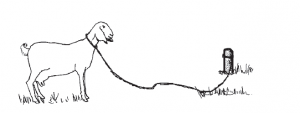
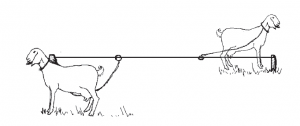
The farmer must be careful enough not to let the goats get entangled or even strangled, and the area should be free from predators that could attack the goats. The area must also offer some shade from hot sun.
Semi-intensive System
In this system, the goats are restricted to move in the night and certain part of the day. They are allowed to graze at a certain time of the day, in the company of a herdsman. In the semi-intensive system, the goats are opportune to supplement their diet as well as do some selective feeding to overcome dietary deficiencies. Stall feeding is done when the goats are confined. The kids are left in the pen while the adults are taken out to graze. Additionally, uncontrolled mating is common because the separation of bucks and does is not common. Another option under this system is allowing the goats to graze in fenced paddocks.
Extensive System
In this system, the goats are allowed to browse and graze large areas of land that are marginal in nature and/or are not suitable for other agricultural purposes. This is a common system in regions with arid and semi-arid climates. This is the production system used for meat goats but rarely for dairy goats. The extensive system is also common in Nigeria. Little management is done except allowing the animals to graze during the day, and they are locked up in the pens or yards in the night. The goats usually roam about looking for food or water themselves, and they can be fed with crop residues and weeds after harvest. Their droppings are also collected and used as manure.
Why Housing is Important in Goat Production?
- For climate control: Goats need a shelter to protect their health. With good housing, a waterproof roof and draught-proof walls to keep out damp and draughts, you will avoid goats becoming sick.
- For collection of manure: By keeping goats inside, you can collect their droppings and use these as a fertilizer. Keep collected droppings protected from rain and sunshine when storing as to maintain the fertilizer value.
- For easy observation: Good housing makes it easier to keep an eye on your goats. You can detect and act more easily when the goats are sick, come into heat, during mating, pregnancy and kidding when the goats are kept in a pen than if they wander around freely outside.
- For safety purpose: When you provide good housing for your goats, you protect them against stray dogs, predators, snakes or thieves. This also prevents them from damaging crops.
How to Build a Goat House or Shed
- Location: The goat pen must be near the home so that you can easily keep an eye on them.
- Positioning: The house should be built in the east-west orientation. This prevents the sun from heating up the house too much.
- Ventilation: Provide enough ventilation in the pen. Ventilation is essential to prevent respiratory diseases and body overheating to which goats are very susceptible. Make the shed sufficiently high and be sure to there are openings for ventilation in the roof or walls.
- The floor: The floor of the stall must be easy to keep clean and should remain dry. A damp and dirty floor stimulates the development of all kinds of germs and worms. The goats also get wet and dirty, cool down too much, are susceptible to diseases and produce poorly. You can put bedding or litter materials in order to keep the animals clean and to provide good insulation in a cold climate or season. Any type of dry organic material can be used as bedding; it can be straw, weeds, dry grass or leaves, sawdust, etc.
- Space requirements: In all housing systems the required roofed space per adult is about 1 – 1.5 square metres, depending on the breed. Some separate pens of about 2 by 2 metres are advised for kidding and sick animals.
Housing Systems in Goat Farming
There are two basic housing systems in goat production. They are:
- The elevated ground level shed
- Stilted goat shed
The elevated ground level shed
In this system, there is a thatch roof for shade in a fenced night yard provided for the goats. This system is more suitable for arid and semi-arid areas climates where goats graze in the day time and is advised for extensive systems with meat production as the main purpose. It is simple to build and not costly. However, it requires a protective enclosure. The shed floor is raised with earth about 30 cm above the ground level and slightly sloped. In this way water and urine can run off at the same time preventing rainwater to enter the shaded floor, so the floor stays dry. As goats like to play, some rocks or tree trunks can be placed in the yard.
The stilted goat shed
As the stilted goats shed requires quite some investment, the system is more applicable for intensive milk- and meat production systems and certainly advised for the humid and semi-humid climates. The slatted floor, with about 1.5 cm space between the slats, is elevated about 70-90 cm above the ground. Goats reach the shed by climbing a wooden ramp.
The shed is easy to clean and manure can be efficiently collected. The walls should be built with slats with a width of about 5 cm all around. At the lower part of the wall the slats should be about 5 to 7.5cm apart, at the higher part of the wall (1m and above) between 20 and 30 cm apart. A similar shed can be built on ground level, but the hygiene of the floor has to be considered. Daily cleaning or a system of piling up the bedding is necessary.
Feeding and Drinking Facilities
In each housing system, the supply of water and feed is of great importance. Spreading feed on the floor causes it to be trampled, get dirty and reduces the quality of the feed. A feeding trough which lies above the level of the stall floor makes cleaning easier. A raised placement also prevents goats from standing in it or their droppings and/or urine getting in it. This is also true for the placement of watering troughs. Provide clean drinking water as needed for the animals.
Feeds and Feeding in Goat Production
The progressive goat producer or farmer should want optimum performance from his animals. Therefore, quality forage, hay grains, and the utilization of forbs and browse plants, crop residue and crop by-products can provide a balanced feed program for goats raised for meat.
Pastures
Pastures are usually the cheapest source of essential nutrients for grazing livestock. Good permanent pastures containing a mixture of cool season perennials or reseeding legumes, warm season perennials grasses and temporary forages should provide grazing for a year. Some of the best pastures for goats raised for meat are guinea grass, elephant grass, millet, sorghum, sudan grass and a mixture of a grain, grass and clover.
Many of the practices of pasture establishment and management will vary from area to area. This depends on soil types, elevation, growing season, rainfall and drainage. Also many factors influence the choice of grasses, grains and legumes and a combination of the three.
Some factors are:
- Natural adaptation for the plants. (Do they grow well in your area and on your soil?)
- Managerial ability or capability of the meat goat producer. Some varieties of pasture crops need more intense care, fertilization, clipping and controlled grazing then others.
- Available money to invest in pasture establishment.
- How will the crop be used? (For pastures alone, for pasture and hay, for hay alone, to be grazed heavily and continuously or rotationally grazed).
Pastures will yield there most when they are limed, fertilized, clipped on a routine basis and properly managed. Proper grazing management involves paying attention to the following:
- Grazing intensity: Avoid overgrazing and stocking must be adjusted in keeping with available forage.
- It is advisable to limit acreage of some pastures to what the goat can use during period of lust growth.
Some Management Tips for Goats On Pasture
- Provide adequate water and shade.
- Provide goats with mineral mix and trace mineral salt. Do not mix salt and minerals together. Salt may encourage the animal to consume larger quantities of the mineral mix than that is needed.
- Provide animals ready access to hay.
- Provide ample pasture areas for rotating animals. Moving animal among pasture areas at least every 7 days permit pastures rejuvenation, and helps to break the cycle of internal parasite.
Forbs and Browse Plants
Forbs refer to any herbaceous broad leaf plants without regard to family classification. Browse plants includes plants other than grasses and are usually taller plants e.g., trees, shrubs and vines having woody stems.
Goats are natural browsers and weed eaters. Forbs and Browse plants can contribute to an overall feeding program for goats. The nutritive strategy of goats appears to be to select grasses when their protein content and digestibility are high, but switch to forbs and browse plants when the overall nutritive value may be higher.
Keep in mind that when animals are browsing they may, due to starvation or by accident, consume poisonous plants.
Crop Residues and Crop By-Products
Goats provide an excellent means for utilizing crop residues and crop by-products. Vines, stems, leaves and other plant residues that have not been treated with harmful pesticides may be used for feed. These include:
- Plant residues from most vegetable crops, tuberous crops, and green stover of corn, sorghum and millet are excellent feeds when fed green.
- Meal cake from extraction of oil from oil seeds (groundnut, cottonseed, peanut etc.) is high protein feed of excellent nutritive quality. The greatest values of these feedstuffs are their utilization in summer months when perennial forage plants are making little or no growth.
Hay
Hay that is of high quality is an excellent feed for goats. However, legume hay is higher in protein and minerals compared to grass hay. A visual appearance can give much information about the quality of hay such as:
- Lack of seed heads indicates early cutting.
- Coarse stems suggest late cutting while crushed stems indicate early removal.
- Earlier cutting date indicates more digestible nutrients.
- More leaves provide more protein and minerals.
- The presence of weeds or tree leaves mean reduced feed value.
- Green color indicates presence of vitamin.
Concentrates
Grains such as corn, oats and barley are excellent sources of energy. These grains are best utilized by the goats, if they are either cracked, crimped or rolled. If fed whole most of them will go through the animal. Concentrate mixtures (pellets) for goats that contain linseed meal, soybean meal or dried brewer’s grains are available at livestock feed stores or you can click here if you want to prepare your own.
In summary, you can feed your goats with the following:
- Edible grasses and legumes – you can check the list here
- Hays
- Silage
- Crop residues or by-products
- Concentrates – you can find a formula here
For detailed information on feed and feeding, download the eBook at the end of this post.
Water
Water is extremely important. Although goats are probably among the domestic animals that can survive longest without water (camels can do better), more than three days without drinking water may cause their death.
For milk producing or pregnant does, a daily supply of sufficient clean drinking water is essential. A non-producing goat will need about 5-6 litres of drinking water or 10 % of its body weight per day. Of course this depends on the climate and water content of the feeds as well. In arid climates and when consuming mostly hays and straws, the goats need more drinking water. For each litre of milk produced, the doe needs another additional 4 – 5 litres of water. When it is getting hot, goats need more water to cool their body. If they do not drink enough, they will also eat less and their production will go down. Therefore, provide drinking water once a day at a regular time so they can get accustomed to the routine. The cooler the water is, the more they will eat. So try to provide them with as much of and as cool and clean water as possible, although this may be difficult to do in remote areas.
Health and Disease Management
The saying that “an ounce of prevention is better than a pound of cure” should always be in mind of a meat goat farmer, regardless of the size of his operation. It is cheaper to prevent a particular disease from developing in your herd than to treat it, particularly of the entire herd is affected. Diseases can cause severe weight loss and also lead to reduce fertility of your does.
Internal parasites can cause a reduction in feed intake and decreased efficiency of feed utilization. A severe parasitic load can result in weight loss, slow growth rates of animals, and ultimately a loss in potential profits. In extreme conditions, heavy parasitic infestation can lead to death.
Goat Herd Health Guidelines
Parasitism can become a primary constraint to animal production particularly when pastures are overstocked and land is limited for rotational grazing. Farms with a high concentration of animals per acre will require more frequent deworming than farms with a low concentration. The practice of rotational grazing and adequate resting of pastures can facilitate a reduced parasite load.
The most common effect of parasites is to increase the animal’s need for protein. Farmers should also remember that their greatest production loss occurs when weak and underfed animals lack the correct balance of essential nutrients. The approach to the problem or parasitism is to deworm strategically and frequently as advised by your local veterinarian. Work in close collaboration with him to develop your individual deworming program. The regular provision of fecal samples can be useful practice in the determination of the optimal time to deworm animals. This can improve farm cost effectiveness as the laboratory results will indicate whether there is a need to deworm or not.
Remember that haphazard as hoc deworming practices along with non-veterinary advice, the indiscriminate use of broad-spectrum drenches, can lead to problems of drug resistance, reduced livestock performance and ultimately loss in revenue and cash flow. As a general rule of thumb, aim to deworm at least twice per year. However, remember that season, stocking rate, and other factors must be considered. Adult animals are dewormed approximately every three months. Pregnant animals are also dewormed halfway through gestation to prevent the transfer of parasites to the newborn. Kids should be dewormed for the first time at 30 days of age, then again at 60. Two of the best goat dewormers are Panacur and Ivomec, with the latter being generally preferred due to cost and ease of administration. Ivomec is a cattle product and therefore, an adjusted dosage is required; the dosage for goats is 1 ml per 35 kg of body weight.
Important Preventive Measures:
- Vaccinate all adult animals (2 ml ) against Enterotoxemia and Tetanus once per year using Clostridium Perfringens type C and D. Kids should be vaccinated at day 30 and again at 60 days with 1 cc.
- Injection of does with vitamin E or selenium in early to mid-pregnancy has been linked to increased vitality at birth. These can also be administered just before the breeding season.
- At weaning, usually a stressful time for the young kids, administers a coccidiostat in the water for at least one week. Prococ is usually the drug of choice and this aids in the prevention of coccidiosis and scouring.
Reproduction and Breeding
Dairy goats have to give birth before starting lactation. Goats for meat have also to give birth to get kid(s) for fattening. Pregnancy only occurs after effective mating during heat, the gestation period is 5 months. It is possible for goats to produce 3 kids in 2 years, which is often convenient for meat production. With dairy goats the farmer has a choice: to kid his goats once a year or 3 times in 2 years with three much shorter lactations, or even one every two years.
In more temperate climates goats generally only come into heat during the period of shortening days, late summer and autumn. In many parts of the tropics goats come into heat throughout the year, provided there is adequate nutrition. In seasonal wet and dry regions it is advisable to have kid(s) born a few weeks before the rainy season starts.
Signs of Heat (Oestrus)
Does usually come into heat between late August and early March, although Nubian and Nubian crossbred does may have a longer breeding season (July through May). Does stay in heat 1 or 2 days, and if not bred, come back into heat every 18-21 days until they are bred and conceive or until the end of the heat season.
Signs of heat are:
- Unusual restlessness and bleating
- Continuous twitching of the tail
- Decreased milk production
- Decreased appetite
- Redness and swollen around the vulva
- Mucous discharge that wets the hair around the tail
- Attempts to fight molest and annoy other goats
- Rubbing against other animals
- Mounting other animals or standing to be mounted
- Age to Breed
If the virgin doe weighs 80 to 90 pounds, she may be bred as early as 10 to 12 months of age. If the doe is 15 to 18 months old, she should be bred before she weighs 80 to 90 pounds.
Do not breed smaller animals even though they may be old enough. They seldom gain their full adult size when bred as undersized yearlings and may have kidding problems.
If a doe is not big enough at the earlier age and has not been sick, check the feeding and management program.
Gestation Period
The gestation period is about 150 days or 5 months. Does usually give birth to 2 kids, but may have 3 or even 4 at one kidding.
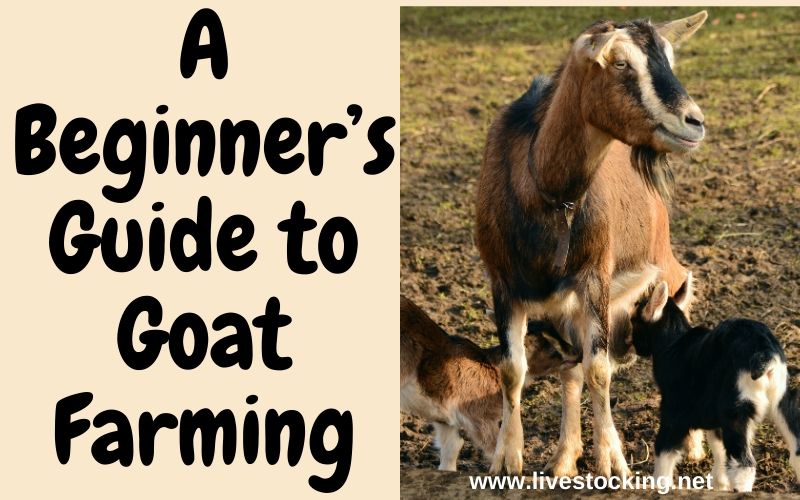
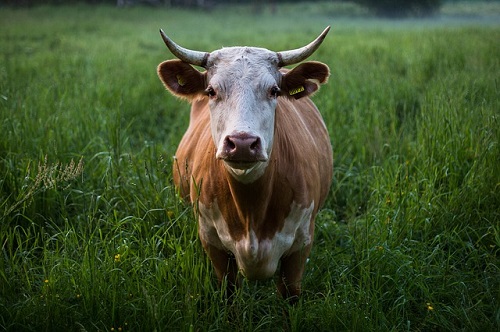
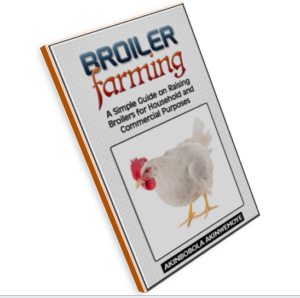
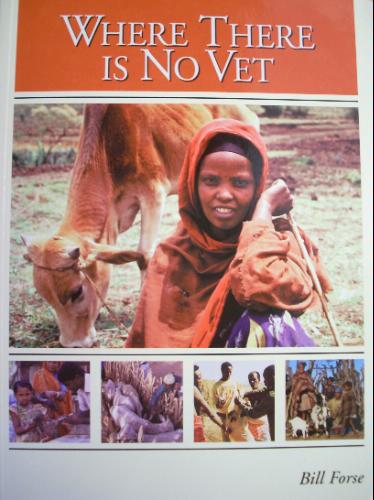
thnks please can u send me Ebook for how to start goat farming
and helping for this business
The download link is below the article
I really appreciate your help on the bigginas guide to goat farming quit simple and informative.
Hope to get more information from you any time any day .
From Nigeria
It’s a hopefully project indeed